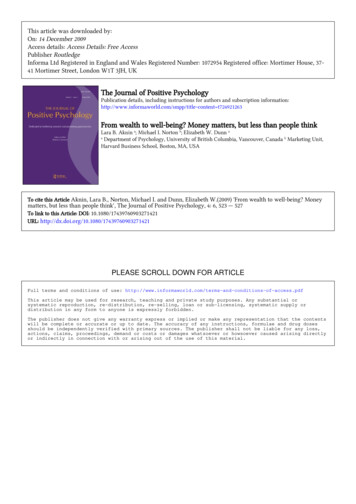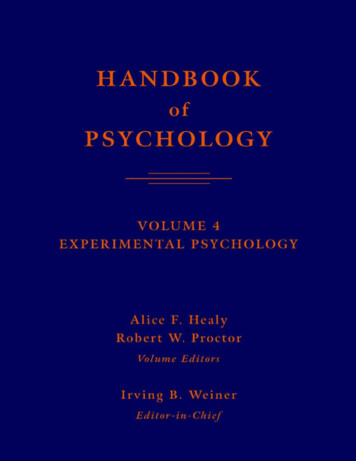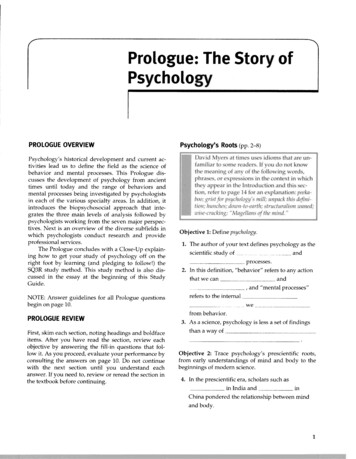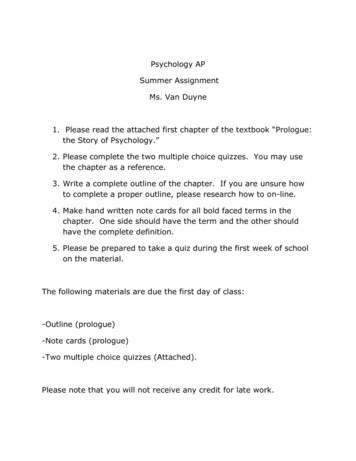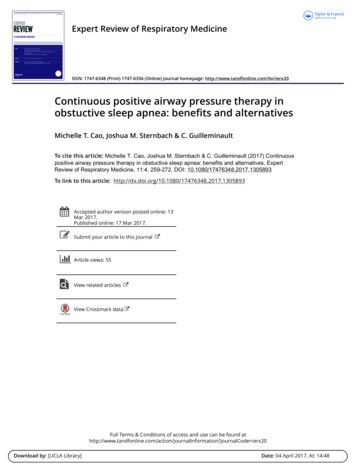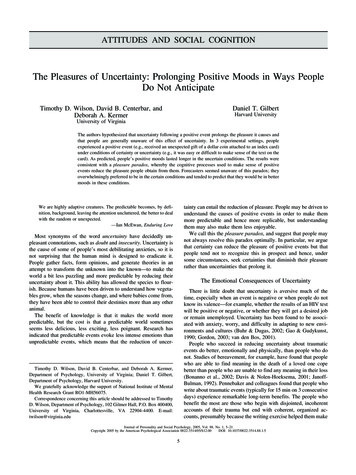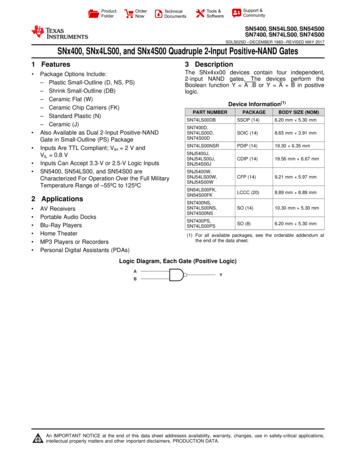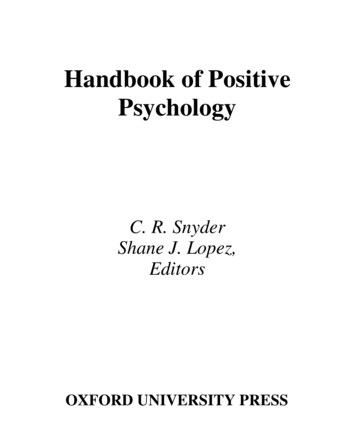
Transcription
Handbook of PositivePsychologyC. R. SnyderShane J. Lopez,EditorsOXFORD UNIVERSITY PRESS
HANDBOOK OF POSITIVE PSYCHOLOGY
This page intentionally left blank
HANDBOOK OFPOSITIVE PSYCHOLOGYEdited byC. R. SnyderShane J. Lopez12002
1Oxford New YorkAthens Auckland Bangkok Bogotá Buenos Aires Cape TownChennai Dar es Salaam Delhi Florence Hong Kong Istanbul KarachiKolkata Kuala Lumpur Madrid Melbourne Mexico City Mumbai NairobiParis São Paulo Shanghai Singapore Taipei Tokyo Toronto Warsawand associated companies inBerlin IbadanCopyright 2002 by Oxford University PressPublished by Oxford University Press, Inc.198 Madison Avenue, New York, New York 10016Oxford is a registered trademark of Oxford University PressAll rights reserved. No part of this publication may be reproduced,stored in a retrieval system, or transmitted, in any form or by any means,electronic, mechanical, photocopying, recording, or otherwise,without the prior permission of Oxford University Press.Library of Congress Cataloging-in-Publication DataHandbook of positive psychology / edited by C. R. Snyder and Shane J. Lopez.p. cm.Includes bibliographical references and indexes.ISBN 0–19–513533–41. Psychology. 2. Health. 3. Happiness. 4. Optimism.I. Snyder, C. R. II. Lopez, Shane J.BF121 6.H212 2002150.19'8—dc2120010215841 3 5 7 9 8 6 4 2Printed in the United States of Americaon acid-free paper
To the positive in all of us . . .
This page intentionally left blank
ForewordIt gives me great joy to know that so many scientists—many of whom have contributed tothis landmark volume—are striving to inspirepeople to develop a more wholesome focus onthe positive aspects of life. I am convinced thatone day these scientists will be recognized asvisionary leaders, whose research helped toidentify, elevate, and celebrate the creative potential of the human spirit.Until recently, I had rarely heard about scientific research that examined the lifeenhancing power of “spiritual principles”—positive character traits and virtues such as love,hope, gratitude, forgiveness, joy, futuremindedness, humility, courage, and noble purpose. Perhaps my long-standing interest inthese spiritual principles and character traits isbest understood by sharing with you the following perspective. My grandfather was a physician during the Civil War, and several of myown children are physicians today. I think wewould all agree that my children, because of theenormous number of dollars earmarked formedical research during this past century, knowa hundred times—perhaps a thousand times—more about the human body than my grandfather ever did. But I have always wondered:Why is it that we know so little about the human spirit?The research highlighted in this volume provides overwhelming evidence that many talented scholars and award-winning researchersare reclaiming what was once at the core of theirdiscipline: the psyche, the study and understanding of the power of the human spirit tobenefit from life’s challenges. The men andwomen who have written chapters for thishandbook, as well as countless more inspired bytheir research, are courageously gathering dataand testing hypotheses to help us learn moreabout an essential question that perhaps servesas the North Star for a positive psychology:What enables us to override our biological inclinations to be selfish and instead find meaning,purpose, and value in nurturing and upholdingthe positive qualities of our human nature?In fact, I am more optimistic than ever thatone day soon a group of scientists will publishfindings that will advance humankind’s understanding of a spiritual principle that has been atthe core of my own life’s purpose: agape love.One of my favorite sayings is, “Love hoardeddwindles, but love given grows.” Love is morepowerful than money; unlike money, the morelove we give away, the more we have left. Perhaps, dear reader, you will be the researcher whostudies a spiritual principle such as agape lovescientifically or empirically. Wouldn’t all of humankind benefit from knowing more about thisfundamental “law of life,” and many others?Finally, I am hopeful that as current and future researchers catch the vision of a positivepsychology, and as foundations and governments initiate programs to support this groundbreaking and beneficial work, we will all forgeahead in a spirit of humility. We know so little,my friends, about the many gifts that God hasgiven to each and every human being. As thetruly wise tell us, “How little we know, howeager to learn.”Radnor, PennsylvaniaSir John Templeton
This page intentionally left blank
PrefaceHow often does one have the opportunity toedit the first handbook for a new approach topsychology? We had a “once-in-a-lifetime”scholarly adventure in preparing this Handbookof Positive Psychology. There was never a question in our minds about editing this volume.We were at the right place at the right time,and the book simply had to happen.Fortunately, our superb editors at OxfordUniversity Press, Joan Bossert and CatharineCarlin, shared our enthusiasm about the necessity of this volume, and they made this hugeeditorial undertaking seamless in its unfolding.The authors we invited to write chapters readilyagreed. Much to our delight, this handbook almost took on a life of its own. We attribute thisto the vitality of the authors, along with thepower of their positive psychology ideas andscience.We complemented each other as an editorialteam. Snyder was a stickler for detail and yetsought ingenuity in thought and expression.Lopez saw linkages in ideas, would call upon therelated literatures, and brought unbridled enthusiasm to the editorial process. What thiscombination produced was a line-by-line analysis and feedback in every chapter. In short, wewere “hands-on” editors. Given the statureof the contributing scholars, with numerousawards, distinguished professorships, andhonorary degrees, they certainly could havebalked at such editorial scrutiny. But they didnot. Instead, they used our feedback and revisedtheir already superb first drafts into stellarsubsequent chapters. We are indebted to thisremarkable group of authors for their patiencein this process. Their dedication to excellence can be seen in the chapters of this handbook.In order to help readers in gaining a sense ofthe topics contained in each chapter, we haveasked our expert authors to identify sources thatprovide excellent overviews of their areas.Therefore, in the reference section of each chapter, the authors have placed an asterisk in frontof such key readings. We encourage our readersto use these background sources when more detailed descriptions of a topic are desired.Now, before you peruse the contributions ofthe outstanding scholars, consider the following. . . Imagine a planet where the inhabitants areself-absorbed, hopeless, and filled with psychological problems and weaknesses. Confusion,anxiety, fear, and hostility race through theirminds. These creatures “communicate” witheach other by lying, faking, torturing, fighting,and killing. They hurt each other, and they hurtthemselves. Of course, this imaginary planet isnot far away—we call it Earth. Although theseproblems do exist, they are made to loom evenlarger because of the propensities of psychologyand its sister disciplines to focus on the weaknesses in humankind. Now let us imagine another planet where the inhabitants are caring,hopeful, and boundless in their psychologicalstrengths. Their thoughts and feelings are clear,focused, and tranquil. These creatures communicate by spending time talking and listening toeach other. They are kind to each other and tothemselves. Again, this imaginary, not-so-far-
xPREFACEaway planet is Earth. These positive descriptionsaptly fit many of the people on Earth. In thisregard, hardly anyone (including some cynics)quibbles with this latter conclusion. But no science, including psychology, looks seriously atthis positive side of people. It is this latter troubling void that positive psychology addresses.As such, this handbook provides an initial scientific overview of the positive in humankind.As with any new and promising paradigm, thereactions of people such as you will determinethe fate of positive psychology. Although science certainly advances on the merits of particular ideas and facts, it also is true that the success of a new theory rests, in part, upon itsability to gather supporters. On this point, thishandbook may enable you to cast a more informed vote as to the enduring viability of positive psychology.Lawrence, KansasC. R. SnyderShane J. Lopez
ContentsContributors,xvPART III. EMOTION-FOCUSED APPROACHES5 Subjective Well-Being: The Science ofHappiness and Life Satisfaction, 63PART I. INTRODUCTORY AND HISTORICALOVERVIEW1 Positive Psychology, Positive Prevention,and Positive Therapy, 3martin e. p. seligmaned dienerrichard e. lucasshigehiro oishi6 Resilience in Development,7 The Concept of Flow,PART II. IDENTIFYING STRENGTHS2 Stopping the “Madness”: PositivePsychology and the Deconstruction of theIllness Ideology and the DSM, 13james e. maddux3 Widening the Diagnostic Focus: A Casefor Including Human Strengths andEnvironmental Resources, 26beatrice a. wrightshane j. lopez74ann s. mastenmarie-gabrielle j. reed89jeanne nakamuramihaly csikszentmihalyi8 Positive Affectivity: The Disposition toExperience Pleasurable EmotionalStates, 106david watson9 Positive Emotions,120barbara l. fredrickson10 The Social Construction of SelfEsteem, 135john p. hewitt4 Toward a Science of Mental Health:Positive Directions in Diagnosis andInterventions, 45corey l. m. keyesshane j. lopez11 The Adaptive Potential of CopingThrough Emotional Approach, 148annette l. stantonanita parsajennifer l. austenfeld
xiiCONTENTS12 The Positive Psychology of EmotionalIntelligence, 159peter saloveyjohn d. mayerdavid caruso23 The Passion to Know: A DevelopmentalPerspective, 313michael schulman13 Emotional Creativity: Toward“Spiritualizing the Passions”, 172james r. averill24 Wisdom: Its Structure and Function inRegulating Successful Life SpanDevelopment, 327paul b. baltesjudith glückute kunzmannPART IV. COGNITIVE-FOCUSED APPROACHESPART V. SELF-BASED APPROACHES14 Creativity,25 Reality Negotiation,189dean keith simonton15 The Role of Personal Control in AdaptiveFunctioning, 202suzanne c. thompson27 Authenticity,382susan harterellen langer28 Uniqueness Seeking,231395michael lynnc. r. snydercharles s. carvermichael f. scheier18 Optimistic Explanatory Style,26 The Truth About Illusions: Authenticityand Positivity in SocialRelationships, 366william b. swannbrett w. pelham16 Well-Being: Mindfulness Versus PositiveEvaluation, 21417 Optimism,351raymond l. higgins24429 Humility,411june price tangneychristopher petersontracy a. steenPART VI. INTERPERSONAL APPROACHES19 Hope Theory: A Member of the PositivePsychology Family, 257c. r. snyderkevin l. randdavid r. sigmon20 Self-Efficacy: The Power of Believing YouCan, 277james e. maddux30 Relationship Connection: The Role ofMinding in the Enhancement ofCloseness, 423john h. harveybrian g. pauwelssusan zickmund31 Compassion,434eric j. cassell21 Problem-Solving Appraisal andPsychological Adjustment, 288p. paul heppnerdoug-gwi lee22 Setting Goals for Life andHappiness, 299edwin a. locke32 The Psychology of Forgiveness,446michael e. mcculloughcharlotte vanoyen witvliet33 Gratitude and the Science of PositivePsychology, 459robert a. emmonscharles m. shelton
CONTENTS34 Love,47243 Positive Responses to Loss: PerceivingBenefits and Growth, 598susan hendrickclyde hendrick35 Empathy and Altruism,xiiisusan nolen-hoeksemachristopher g. davis48544 The Pursuit of Meaningfulness inLife, 608c. daniel batsonnadia ahmaddavid a. lishnerjo-ann tsangroy f. baumeisterkathleen d. vohs36 How We Become Moral: The Sources ofMoral Motivation, 49945 Humor,619herbert m. lefcourtmichael schulman46 Meditation and Positive Psychology,PART VII. BIOLOGICAL APPROACHES37 Toughness,47 Spirituality: Discovering and Conservingthe Sacred, 646515richard a. dienstbierlisa m. pytlik zilligkenneth i. pargamentannette mahoney38 A Role for Neuropsychology inUnderstanding the Facilitating Influence ofPositive Affect on Social Behavior andCognitive Processes, 528PART IX. SPECIAL POPULATIONS ANDSETTINGSalice m. isen39 From Social Structure to Biology:Integrative Science in Pursuit of HumanHealth and Well-Being, 541carol d. ryffburton singer40 Toward a Biology of Social Support,PART VIII. SPECIFIC COPING APPROACHES41 Sharing One’s Story: On the Benefits ofWriting or Talking About EmotionalExperience, 57342 Benefit-Finding and BenefitReminding, 584howard tennenglenn affleck48 Positive Psychology for Children:Development, Prevention, andPromotion, 663michael c. robertskeri j. brownrebecca j. johnsonjanette reinke556shelley e. taylorsally s. dickersonlaura cousino kleinkate g. niederhofferjames w. pennebaker632shauna l. shapirogary e. r. schwartzcraig santerre49 Aging Well: Outlook for the 21stCentury, 676gail m. williamson50 Positive Growth Following AcquiredPhysical Disability, 687timothy r. elliottmonica kurylopatricia rivera51 Putting Positive Psychology in aMulticultural Context, 700shane j. lopezellie c. prosserlisa m. edwardsjeana l. magyar-moejason e. neufeldheather n. rasmussen
xivCONTENTS52 Positive Psychology at Work,715nick turnerjulian barlinganthea zacharatosPART X. THE FUTURE OF THE FIELD53 Positive Ethics,731mitchell m. handelsmansamuel knappmichael c. gottlieb54 Constructivism and PositivePsychology, 745michael j. mahoney55 The Future of Positive Psychology: ADeclaration of Independence, 751c. r. snydershane j. lopezwith contributions fromLisa AspinwallBarbara L. FredricksonJon HaidtDacher KeltnerChristine RobitschekMichael WehmeyerAmy WrzesniewskiAuthor Index,769Subject Index,793
ContributorsGLENN AFFLECK ,Professor, Department ofPsychiatry, University of ConnecticutHealth Centerogy and Human Development and FamilyLife, University of KansasDAVID CARUSO
psychology? We had a “once-in-a-lifetime” scholarly adventure in preparing this Handbook of Positive Psychology. There was never a ques-tion in our minds about editing this volume. We were at the right place at the right time, and the book simply had to happen. Fortunately, our superb editors at Oxford University Press, Joan Bossert and .
